#how to write alibata
Explore tagged Tumblr posts
Text
How I Write Baybayin (Handwriting and Straight-cut Nib Calligraphy) Subtitle: This is a freaking long-ass post so be warned now
You can read the entirety of this post as is, or you can go straight to the calligraphy portion. It’s at the end of the post (sorry dunno how to link that portion here).
Writer’s Note: First and foremost, I will advise everyone who reads this somewhat master post that I am not an authority when it comes to how baybayin is written, as what you shall be reading is just based mostly on my own experiences on how the characters are written and comparing them with other writing systems that are based on syllables rather than individual letters, like the Japanese Kana and the Korean Hangul, among others. This is because baybayin are not technically letters (individualized, can’t stand alone, only comes either as vowel or consonant but not both, you get the picture), but rather are syllables (i.e. the consonants have free vowels with them lol) that form words.
Also, as far as I know regarding how the baybayin texts are originally written pre-Hispanic colonization era, some of the written texts in the Philippines (or at least, those that survived, or I remember seeing in old history books) were written from right to left, top to bottom. This also coincides with other writing methods in some parts of Asia that also read from right to left. The technique of writing and reading from left to right may be a Western invention, in my opinion so I just did some of the strokes in the baybayin characters go from right to left, except for the straight-cut nib section. Again, I am no authority so I’m just doing what I think makes sense to me, as there is no existing ANCIENT written rules on the stroke order of the baybayin. Other people may disagree with my stroke orders here due to various reasons, but if you’re into what I did then feel free to learn from them, for free. *heart*
This author’s other notes: I won’t be elaborating the history of baybayin here because that would take around (counts how many years I spent in school) 5ever as it basically intertwines with the “current” history of the Filipino people. I put quotes on “current” because every decade or so, some written histories get re-written based on some evidences or what, and I totally respect that. It’s like in scientific papers: legit today, debunked tomorrow. And it’s completely OK, because THE MORE YOU KNOW~
Also this author’s note: I keep calling baybayin alibata, because that’s what they were called when I was a kid and how it was taught by history teachers before the process called “being politically-correct” became the norm. It’s because alibata was supposedly an incorrect term which signifies that the characters were letters based on Arabic, but apparently it wasn’t so.. Yeah. I’m just saying, so the kiddies would know. And if you’re like me who also refers to baybayin as alibata, let’s get a high-five! (Cause you’re also old, but gold =D) Some biased history FTW lol ok let’s get started.
Handwriting Alibata Baybayin Strokes with a Bamboo pen (or Ballpen, or Pencil, w/e floats your boat)
OK, before I start I would be first putting here the somewhat traditional ordering of the baybayin, which is:
A BA KA DA E GA HA I LA MA NA NGA O PA RA SA TA U WA YA
As well as the borrowed/loan syllables (which correspond to C, F, J, Ñ, Q, V, X, and Z were apparently added some 6-7 years ago, in which I didn’t get the memo x__x)
CA FA JA ÑA QA VA XA ZA
OK, now that’s out of the way, it’s time for the actual stuff. For ease of practice and recall, I’m grouping the letters based on how I write them and in turn, their forms. This would make sense as the pictures move along, don’t worry. The forms are built sequentially, I tried making that a bit obvious in the diagrams, but there are red arrows in case I wasn’t that clear. For those that only have one picture or arrows in the sequence, I would be implying that the form is built on a single stroke.
Group 1: A, MA, PA, YA, FA, JA, VA
OK, let’s start with A:
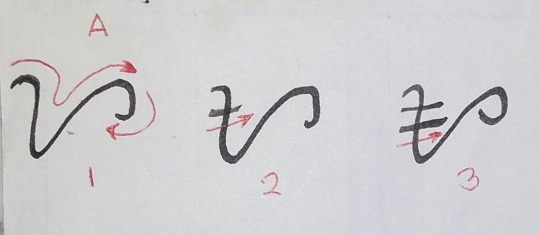
Then MA:
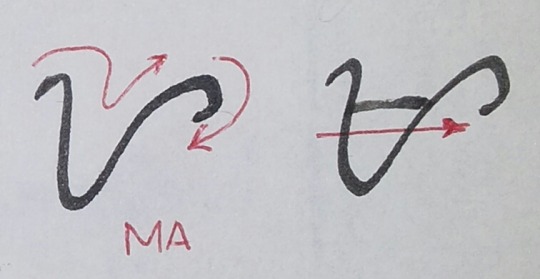
PA:
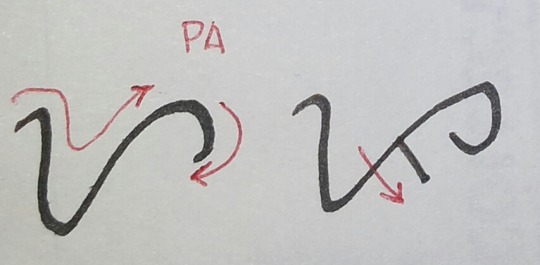
YA:
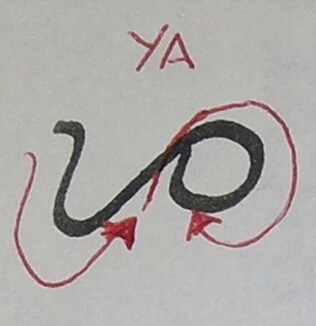
FA:

JA:

VA:

Group 2: E/I (more on that later), KA, DA, HA, RA, CA, QA, XA
I’ll start with HA because it’s a foundational stroke:
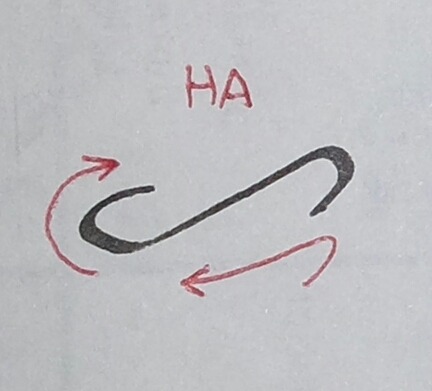
E:
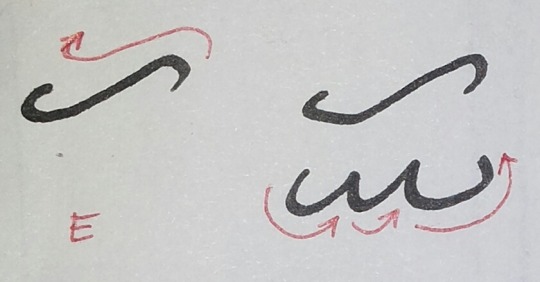
I looks structurally like E, but only with a vertical stroke on its hat.

It’s because originally, E and I were the same character and whether it should be read as a syllable from the E or I line depends on how the reader would read it and the dialect used in writing the words, like it’s a fill-in-the-blanks kind of thing. It’s also the same with O and U, so if you see that part yeah they look alike. This is also the reason why revisions on writing the E-I and O-U consonants were made, but that would be for a later part. Just be patient for now. =D
Ok, moving on, we’ll go to KA:
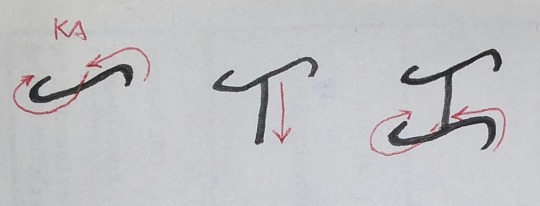
DA:
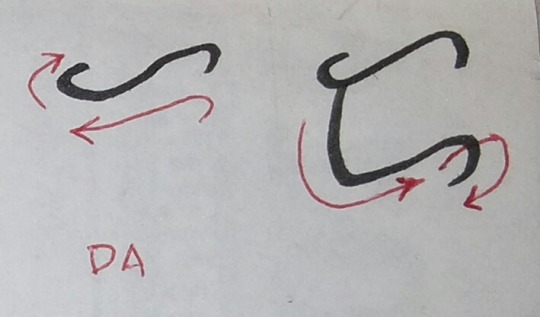
RA:

A short note on DA and RA: In olden times, these two were only one character, and are used interchangeably based on word usage, thus for words such as doon/roon, which both mean way over there one is used for passive and one is used directly (sorry not a speech comm person). This is also the case for marami and ang dami (both meaning “there are many/there is much” but one is active and one is passive. Madami is, IMHO grammatically incorrect. But then again, I’m not a speech comm person so sorry if these are wrong. I’m just saying).
CA:

QA:
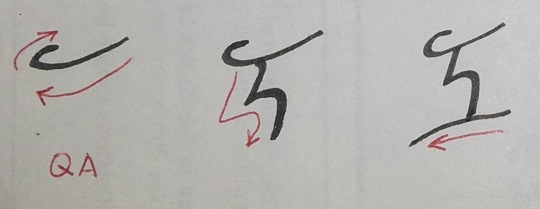
XA:

Group 3: O/U, GA, SA, ZA
Just like in E/I, O and U are also structurally similar. To make an O:
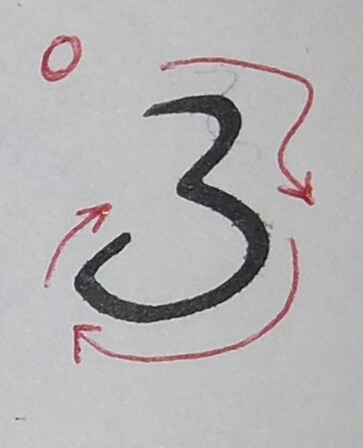
To make it a U, just put a vertical line on the right side:
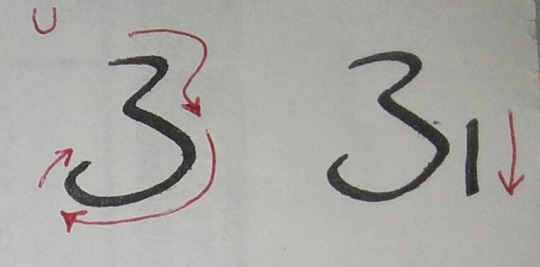
GA:
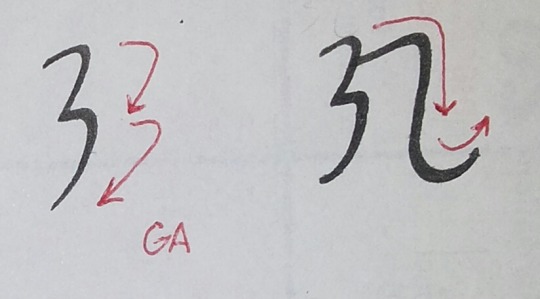
SA:

ZA:
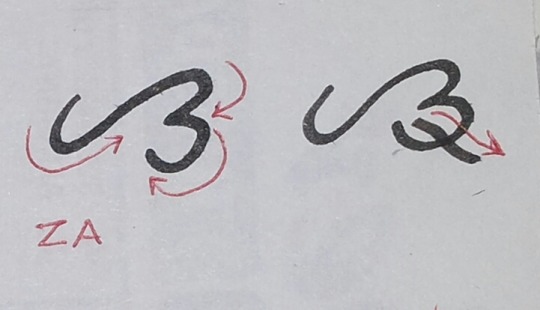
Group 4: LA, NA, TA, ÑA
I grouped this bunch based on having a downward stroke in the middle of the form. The initial strokes are written as a single stroke from left to right, like in the first group.
LA:

NA:
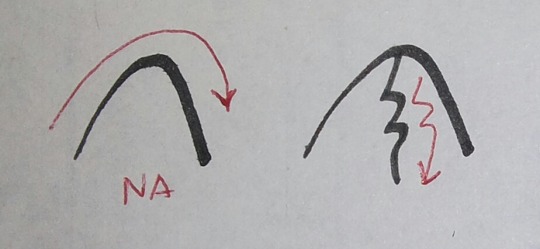
TA:

ÑA:
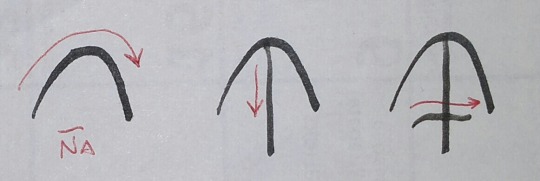
Group 5: I have no idea where to put BA, NGA, and WA so I just made a miscellaneous group lol but they deserve just as much love OK?
BA:
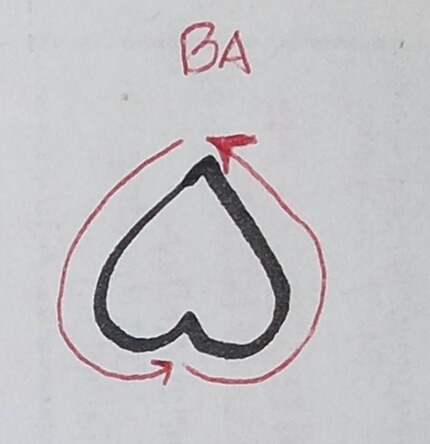
NGA:
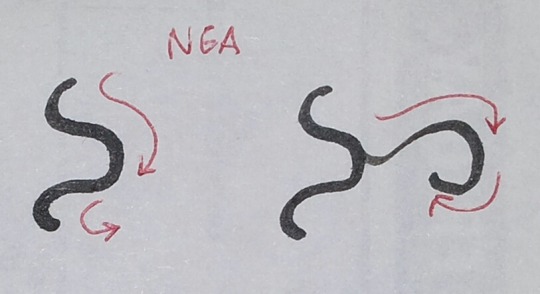
WA:

How the E, I, O and U lines are written:
In writing E, I, O and U (as in the case for the example below, which is GE, GI, GO, and GU), the original positions of the additional marks (such as the vertical lines for I and U) were kept but in order to differentiate E from I and O from U, the marks were made to be further distinct. For instance, GE is basically GA which has a horizontal line above it, while GI has a dot above it. As for GO, it has a dot below and GU has a horizontal line.

GI and GO can have either a hollowed dot like in the sample, or can also be filled like the samples below. It’s based on personal preference. Also I used G for the samples because it looks nice, fun to write, and most other examples of alibata on the internet use BA as their examples for this portion. Whoops, I meant, baybayin. XD
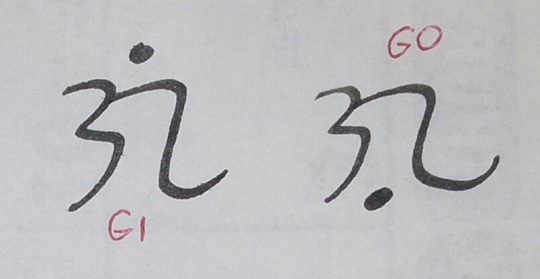
Vowel Killers: Invented by People who Needed It
I’m not entirely sure why vowel killer was the term used but it does tell it exactly what it does: it silences the vowels in the characters (because baybayin is composed of syllables) in order to make separate letters. It was invented by some Spanish friar who couldn’t properly write the native words because words that have consonants at the end were written incompletely. I.E. the word DOON (over there) was written as DO-O in baybayin. It was such a drag that he decided to introduce the Spanish/Latin alphabet by making baybayin characters that acted as alphabets, which is essentially killing all the vowels and leaving the consonant behind. So instead of using dots, the friar made a cross underneath the symbol which they called a kudlit (for obviously non-secular reasons), so that the words with consonant ends can be written and read as they were. As per the revision that was instated a few years ago, in order to make the baybayin a bit more secular, more forms of the vowel killers were made, which in my opinion look better than the original kudlit, because they look more organic with the forms.

As you can see in the pic of the letter G above, the first on the left is the original kudlit, which is shaped like a cross. The next one has an X, or sinawali (it’s literally based on the patterns of hard, woven rattan walls called sawali which look like X’s), the next one is called a kawil (sorry dunno where that came from) and the right-most one has a pamudpod (which may have come from the word “pudpod/pudpud” literally meaning grinding or repeatedly striking something on a hard surface or on a whetting stone till it disappears or becomes flat/dull, so pamudpod is the surface that makes the item pudpod like a used pencil or eraser. Do I even make sense anymore? Oh well, YOLO).
Stringing them All Together
My personal preference is using a kawil on horizontal writing (left to right) and using a pamudpod when writing vertically. I think the overall impact is better. But then again, it’s just my personal idea. Using any of the vowel killers are, like the filled or hollow dots on I and O are personal preferences, as long as there is consistency in usage.

If you can read the above and understand where the reference came from, you probably also call baybayin as alibata, and we should totally get some tea together. XDD It pretty much means “What is there, yonder?” smth idk but yeah, it sounds like that. Old and formal Filipino/Tagalog.

Langit - sky or heaven, Lupa - ground or earth, Araw - sun, and Buwan (or Bulan in Ilokano) - moon
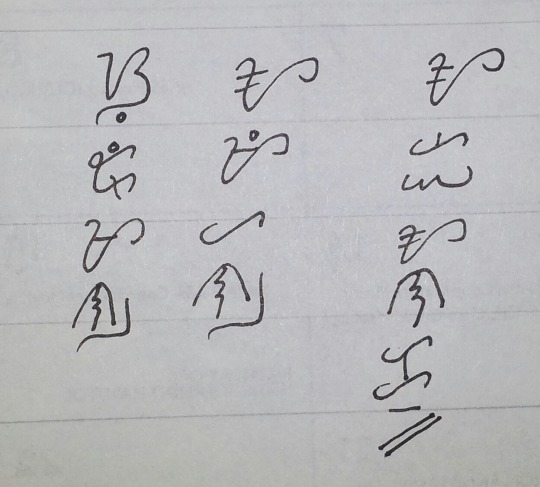
Soliman - A variant of the name Sulaiman/Solomon
Amihan - the northeast monsoon, the nice wind that brings in cool, dry air around November-March. Or if you watched the old and new Encantadia, she’s the protag. XD
The third sampler is a phrase (I ran out of space it was supposed to be a sentence), and vertical double bars are used to end the sentence. I just made them into diagonal slashes to make them look cool. Also I ran out of space. x__x It’s transliterated as a wailing mom looking for her child: Ai anaku (bunga) - Ah, my child (fruit). No space for fruit so it ain’t there.
Author’s extra rant note: Of course, some early Filipinos didn’t wanna use the kudlit due to being comfy with whatever they had at that time, but eventually they gave in. Fast forward to a century later and the baybayin was pretty much dead, as it was for the next 4 centuries or so. Romaji became the norm (except for some of the native tribes that have their own awesome writing systems), but then again some Filipinos didn’t forget it entire time, as many of the revolutionaries’ battle flags had the syllable KA, which is the first syllable of Katipunan, their group which can also be transliterated as “the entire group of the people who meet and come together”. I can’t say more because this is a long-ass post and it’s not about Philippine history. But we can talk about that if you want. Just hit me up with an ask. Warning though: I might just say “thanks for asking but please ask something else” lol j/k XDD
Writing Baybayin using a Straight-cut Calligraphy Pen/ Dip pens with Straight/Oblique Nibs
For this portion of the post, aside from posting pictures of the baybayin in black and white ink I would be pointing out that the techniques I used here are based on Western traditional calligraphy techniques used by scribes of the past, so some of the stroke patterns would be a lot different from the handwritten strokes above. But then again, if you clicked the link to get here straight away instead of reading the previous portions, well you won’t be having that much problems then. Also I will assume you already learned how to write baybayin so I’ll leave you at that. For the black baybayin, I used a calligraphy fountain pen with a 2mm straight-cut nib from the Visual Deck Set – Calligraphy box, not sure where you can buy it online but I bought mine at the National Bookstore because nobody wants to buy it. (Should’ve also bought the other calligraphy set while they’re on sale. LOL Just saying XDD). The surface is just the back of old calendars because I was just testing the strokes. For the white baybayin, I used a Speedball™ C-2 oblique-cut nib and for the ink, it’s glittery silver poster paint from Reeves™ (diluted with dH2O), and the surface is some random paper with nice surface and sizing which my father got from the office. (Apparently you can’t print anything on it so it aged well there until my father disturbed the papers’ sleep and brought them home. Now I ran out of both the calendar and the weird red paper so business is halted for a bit. XDD) Again, these are all based on how I write stuff so it’s pretty much a personal opinion, it’s not absolute but it certainly works for me so here you go.
Group 1
A:


MA:
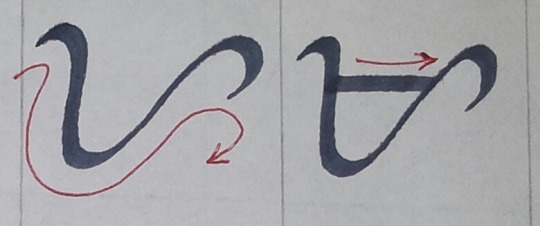
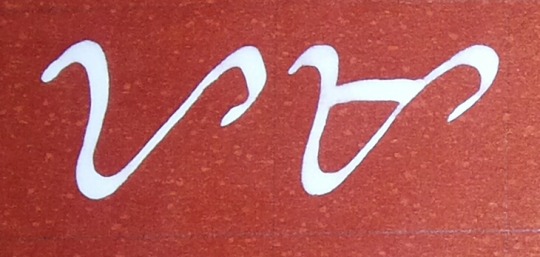
PA:


YA:


FA:
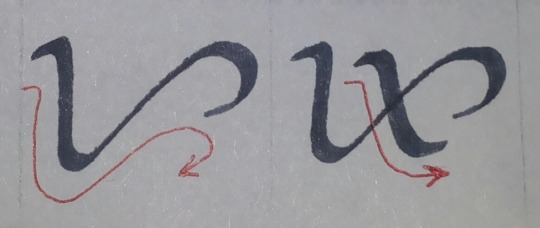
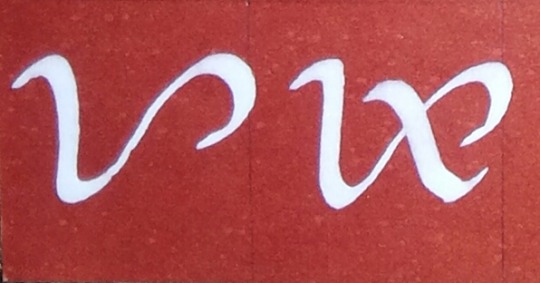
JA:
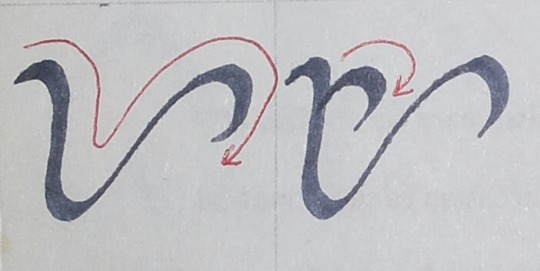

VA:
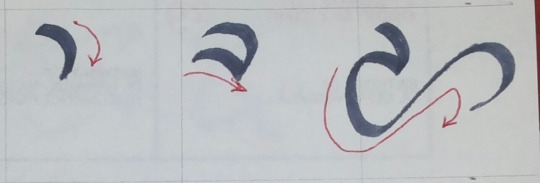
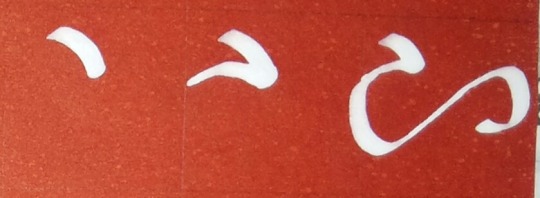
Group 2:
E/I: I’m just putting I here because E and I basically have the same strokes. To make E, just omit the final vertical stroke.


DA:
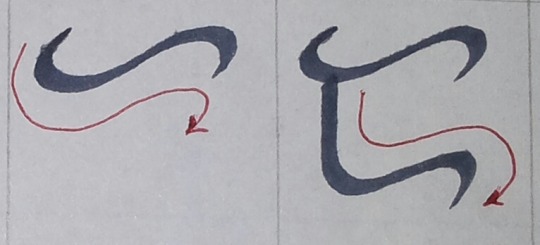
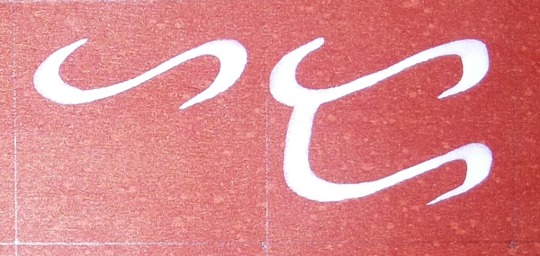
HA:
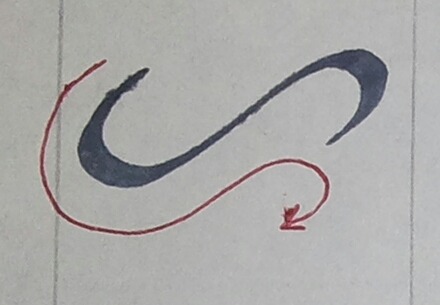
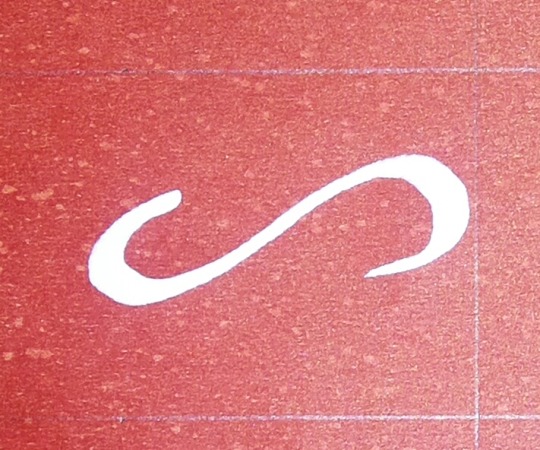
RA:

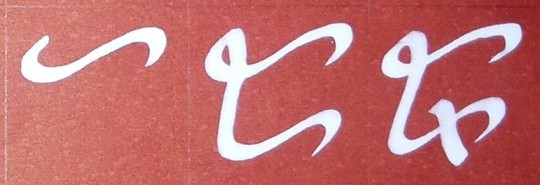
CA:


QA:


XA:


Group 3
O/U: Same with E/I, I just placed U here because O is practically the same, minus the vertical stroke on the right.


GA:
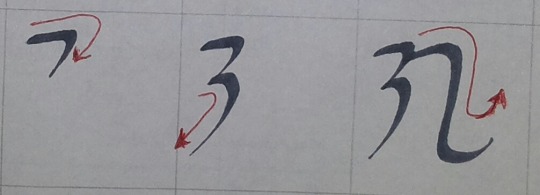

SA:
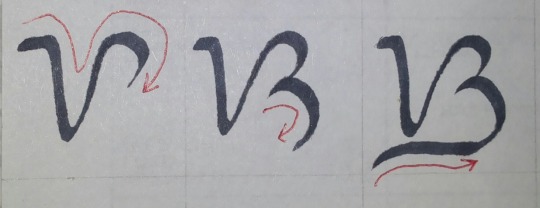

ZA:


Group 4
LA:
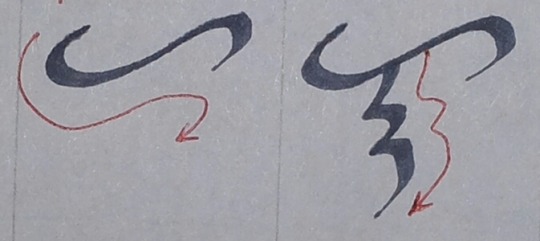

NA:


TA:
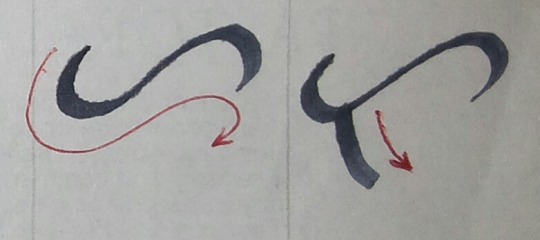

ÑA:


Group 5
BA:
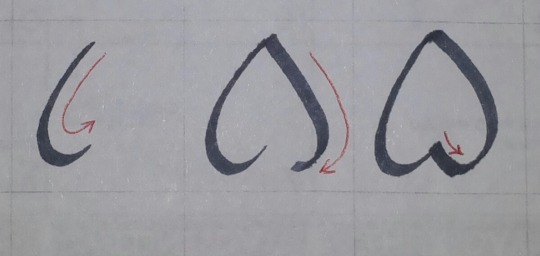

NGA:


WA:

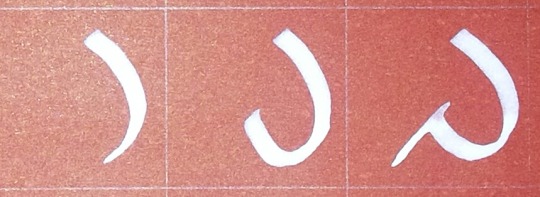
E, I, O, U Lines


Vowel Killers


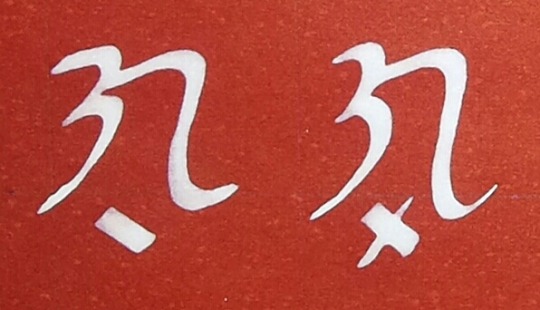
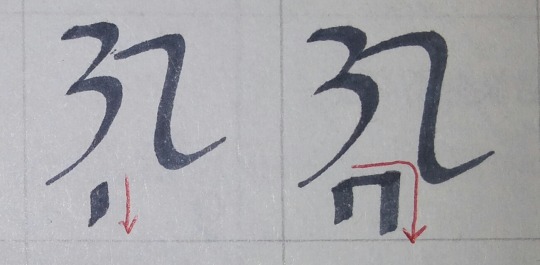
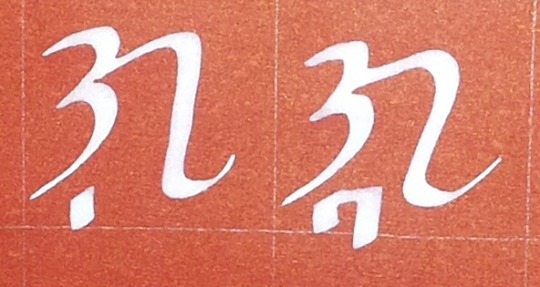


I didn’t make any full sentences or words because I ran out of nice papers, so maybe I’ll post some next time. Sorry. ._.
Author’s final note on writing using baybayin: I’m still on the fence in using the loan letters C, F, J, Ñ, Q, V, X, and Z because in my opinion apart from having redundancies with some other letters, they were just invented to spell out proper nouns that are foreign in origin. I wouldn’t even spell my full name using baybayin, except my nickname and would just rather use the Romaji/Latin Alphabet for ease. As for using baybayin to write foreign words, well, that can be as tricky as using kana to write foreign words. Both methods boil down to localizing a foreign word into how it would be pronounced based on the original language that the writing system belongs to. For instance, the Japanese waifu (as in “My waifu”) is the Japanized form of the English word “wife”, but because their spelling system is a bit different they had to estimate which kana would be suited to approximate how the word would be pronounced and in turn, be spelled. It is also the same case for some Filipino loan words that got Filipinized (and bastardized because long words are hard lol not kidding tho) such as the word istambay which originally came from “standby” and is now shortened to “tambay” which means “just loitering and doing nothing” or in how the young ones use it now: to hang out with friends (and probably just loiter and do nothing lol don’t kill me ok?). Thus, the usage of baybayin (or kana, or hangul, or Arabic because I think their writing is very lovely or whatever writing system you like that works as syllables more than letters) in writing words from another language would take extra steps such as following the rules of the written language or localizing the word first before writing them in whatever letters or syllables that you want. It’s like using what you have then making do with it/winging it out.
The End!!!! No just kidding. But it’s the last part.
To be honest there are a lot of stuff in the internet about baybayin so I’m not that entirely sure if what I have here is pretty much redundant or not. There are a lot of sites so just use your Googling skills to find what you need, although it may be a bit difficult for readers/users who simply try writing and not understanding the entire language so just use with caution. It’s hard to end up with THAT tough guy who has a kanji tattoo that actually spells “poop” instead of whatever it was supposed to be. I actually saw a guy sporting a tattoo that reads FUUBEN in Japanese, which translates to inconvenience. I lol deep inside but the guy seems happy with that so I just let him be.
Well, I hope this long-ass post helped you a lot, or at the very least the stuff made sense to you and it was worth your time reading. Please leave an ask if you have other questions, I’ll try to answer them if and when I can. Have a great day and may the force be with you. =D
#how to write baybayin#how to write alibata#how i write baybayin#baybayin handwriting#baybayin handwriting stroke order#baybayin calligraphy stroke order#baybayin calligraphy
12 notes
·
View notes
Text
𝑷𝒓𝒂𝒚𝒆𝒓 (𝒁𝒉𝒐𝒏𝒈𝒍𝒊) - 𝑸ī

Ao3 ver.
Previous
Next
“Ma, Pa...this is Zhongli. He’s my boyfriend—”
“It’s a pleasure to finally meet you both. Mother, Father.” Zhongli barely even let you finish as he slightly bent his body forward and took your parent’s outstretched hands to press them against his forehead.
“!!!”
You knew it.
You had a feeling that Zhongli, your ever lovable idiot and recently betrothed, wouldn’t give you a chance to properly get him acquainted with your clueless parents before dropping the bomb that was your recent engagement.
Him calling them mother and father respectively just after their introductions was more or less a dead giveaway about the current state of your relationship. This man and his total lack of...of discretion would be the death of you!
But...archon’s knew that his candidness was yet another one of his traits that you loved despite the embarrassment it brought.
Thankfully, your parents had more tact than Zhongli and just casually introduced themselves to him. Though the knowing looks they sent you confirmed that they were now very much aware of what point you were now in your relationship.
“What a fine young man you are, iho ” your mother started, her smile reaching ear to ear as she gazed at the both of you with a warm expression. “You’re so tall and handsome. Tell me, how did this wild child of ours manage to snag a strapping gentleman like you? I still remember when she was a little girl always running around with dirt on her knees and clothes after playing with the boys back in the day”
“MA!” Your face burned as brightly as a ripe Jueyun Chili at your mother’s admission, absolutely mortified as she brought up tales of your tomboyish past.
“She was even crowned Rajah by all the boys, including the ones from neighboring barrios after she dethroned the previous local rascal. But here’s my tough girl now, going out into the world and even finding herself a good son-in-law for us…”
Your mother wiped the small tears at the corners of her eyes with a handkerchief that had her initials embroidered at the corners.
“ Archons, take me now… ”
“You may rest at ease mother, father. I will gladly treat your daughter like the queen that she is for the rest of our lives,” your breath hitches in your throat as Zhongli’s amber orbs meet yours. “She deserves only the best after all and I intend to deliver on that promise.”
.
.
.
“ Iho ...you have my blessing” voiced your father who’d been silent thus far, nodding in approval at Zhongli whom he’d been observing with a critical eye from the moment you both walked inside your childhood home.
“Well then, that takes care of that! While you and Tatay spend some time together, us women will head on over to the kitchen to make lunch for all of us” Your mother claps her hands together, beaming as she loops her familiar comforting arm around your own. “Make yourself at home, Zhongli. We’ll be back shortly with a feast. I’m sure you’ll enjoy experiencing your first boodle fight .”
And so, your mother whisks you off into the kitchen while your father and Zhongli continue their conversation at the sala , the special lambanog your dad has been saving for special occasions being taken out along with his special cups.
You silently hope your betrothed would still be alive after the end of this ordeal.
Maybe Rex Lapis or Barbatos heard your plea, because Zhongli was thankfully still sitting upright by the time you called both men for lunch. However, the tall dark-haired man had a deep blush staining his cheeks as he drank from his cups, whereas your father was waving around his Bolo knife while recounting a tale from his time as a soldier.
“...and then this putanginang gago had the audacity to tell me that our own writing system should be called Alibata when it’s just a term coined by some inutil from Mondstadt. So of course I rammed my itak up his as—”
“PAPA! It’s time to eat!”
“...Oh. Well, we can continue this story later. Come on then, son. There’s never a good reason to let food made by your loved ones get cold”
As if he wasn’t just cursing up a storm, your father grabs the jug of homemade liquor along with his favorite weapon before slipping into the kitchen/dining room for the small feast you and your mother cooked up.
With him gone, you immediately made a beeline to Zhongli who still sat motionlessly in his seat and placed a worried hand on his broad shoulder.
“You okay there? Papa didn’t ruffle you up too much?” You concernedly place your other hand on his cheek, feeling how heated his skin was but thankfully it wasn’t hot enough to cause you any concern.
“Your father has quite the tolerance for alcohol. If the circumstances were different, he’d have drunk me under the table by now…” He licked his lips to savor the last remnants of the alcohol, his mind travelling to a time long long ago when this land, Ma-i, needed guidance from two archons in order to get up on its feet.
It feels like it was only yesterday when he himself walked upon its shores and shared the knowledge of Liyue with these people. Now Ma-i stood proudly just southeast of Liyue, the Principality of Ma-i having withstood the tests of time in spite of their lack of archon.
“Papa is like that. Do you want to get a breather first before we join them for lunch? I’m sure they’ll understand if I—”
Just as you make a move to go back where you came, you’re immediately pulled onto the former archon’s lap as he buries his face into your chest and breathes in your scent.
“It’s fine, dearest. Just...allow me a few moments to get my bearings together and then we’ll join your family for this boodle fight ” he mumbles softly, allowing your softness to ground him back to reality.
“Take all the time you need...” It is second nature for you to wrap your arms around his head and run a hand through his dark locks.
Your parents don’t make a comment when you both finally join them for lunch which was thankfully still warm. Much laughter rang through the walls of your former home as you and your parents took turns teaching Zhongli how to eat with his hands, the refined man having more trouble doing so than he ever did with using a spoon and fork.
#lexsssu writes#genshin impact#genshin#zhongli#genshin zhongli#genshin impact zhongli#zhongli x reader#reader x zhongli#rex lapis x reader#reader x rex lapis#morax x reader#reader x morax#genshin impact zhongli x reader#genshin impact rex lapis x reader#genshin impact morax x reader#character x reader#reader insert
88 notes
·
View notes
Text
Haikyuu boys quoting Andres Bonifacio's letter to Oryang for you (Filipino!Haikyuu)
Note: Andres Bonifacio is a Filipino revolutionary leader and the president of the Tagalog Republic. He is often called "The Father of the Philippine Revolution". He was one of the founders and later Supremo (Supreme Leader) of the Kataas-taasang, Kagalang-galangang Katipunan ng mga Anak ng Bayan or more commonly known as the "Katipunan".
Oryang (Gregoria de Jesus) was the founder and vice president of the women's chapter of the Katipunan of the Philippines. She was also the custodian of the documents and seal of the Katipunan.
This is a fictional letter written by Filipino playwright - Eljay Castro Deldoc. If you wish to read the full version, click here! (Written in Tagalog :> )
A/N: Will I get bashes from this? Most probably. But I love the letter so much I just- 🥺
And I hate how this is so good but my writing skills does not make up for it >=[

• TSUKISHIMA KEI: "Hindi kita nakasalubong upang sa dulo ng kalsada, ako ay liliko sa kanan at ikaw sa kaliwa." Pilit mang itanggi at dinidiin mang hinahayaan lamang niyang tangayin siya ng hibla ng tadhana, sa kaloob-looban niya, batid niyang ninais niya ring mapadpad sa iyong kinaroroonan. Ninais na malaman ang iyong mga hilig, ang iyong mga hiling. Ninais na makita ang iyong mga ngiti, ang masdan ang iyong mga mata, ang marinig ang matamis mong halakhak. At kung sakaling iba pala ang agos ng tadhana, pipilitin niyang kumaliwa kung ito'y patungong kanan at kumanan kung ito'y patungong kaliwa. Lalabanan niya ang mga pangyayaring nakatakda upang masilayan ka. Kaya isang malaking insultonang marinig na kayo'y magkakahiwalay pa dahil sa oras na nasilayan ka niya, batid niyang hindi na siya bibitaw pa.
• AKAASHI KEIJI: "Hindi kailanman ako mauubusan ng mga salita upang maialay sa iyo bilang mga tula." Hindi sapat ang bawat letra sa alpabeto, mga simbolo sa alibata, o ang mga katagang natutunan niya sa paaralan upang isalin ang nararamdaman para sa iyo. Kulang ang limampu't tulang kaniyang naisulat nung gabing huli kang namasdan. Kulang ang mga liriko upang isatinig ang iyong karikitan. Kulang ang salitang 'mahal kita' upang maiparating sa iyo ang namumukadkad na dinadamdam. At kung may iba pamang paraan upang ipamalas ang kaniyang nararamdamang walang pagsisidlan, ito'y susunggabin upang maipakita, maisatinig, at maiparamdam kung gaano ka niya sinisinta.
• BOKUTO KOUTARO: "Hindi tayo sabay na tumawa, nagkatinginan, at tumawa pa nang mas malakas, upang sa paghupa ng halakhak ay may butil ng luha na namimintana sa ating mga mata." Hindi ka niya pinatawa nang sa huli'y iiwan kang luhaan sapagkat nang una kayong naglandas, batid niyang ang puso niya ang may huling salita. Galamay ang iba pang parte ng kaniyang sistema na iisa ang sinisigaw: ang makita kang masaya. Hindi dinidibdib ang kahihiyan sa mga galaw niyang katawa-katawa, o ang mga usap-usapan ng iba na siya'y nahihibang na. Walang epekto ang mapamintas na mga titig ng iba kung ang kaniyang ginagawa ay para mapasaya ka. Sulit ang lahat ng katawa-tawa, 'di kanais-nais, kahiya-hiyang mga salita at mga galaw kung katumbas naman nito ay ang makita kang nagagalak. Kaya ang iyong pagluha ay isang malaking sampal, sapagkat ang bawat minuto'y alay niya sa iyong mga halakhak at ito ang maitururing niyang araw na ayaw niyang dumating pa.
• OIKAWA TŌHRU: "Hindi ka dapat masabik sa akin sapagkat ako'y mananatili sa iyong piling." Parusa ang mahiwalay sa iyong bisig, kalungkutan ang hindi makita ang iyong wangis. Maituturing na paghihirap ang hindi marinig ang iyong tinig. Ngunit 'wag mangamba, sapagkat sa bawat lingon sa iyong paligid, sa bawat salitang iyong naririnig, ipapaalala nito sa iyo ang malayong iniibig. Sa bawat bandang nasisilayan ng iyong mga mata, aangkinin niyang kaniya. Ultimo sa huni ng mga ibon, sa halakhak ng mga dalaga, o kahit sa simpleng pagsigaw ng manlalako, kaniya itong guguhitan ng kaniyang memorya nang sa gayon, malayo man kayo sa piling ng isa't-isa, naipapamalas niya pa rin ang kahulugan ng katagang, 'mahal kita'.
#haikyuu imagines#haikyuu#haikyuu scenarios#haikyuu!!#haikyuu fic#haikyuu fanfic#haikyuu tagalog#haikyuu pinoy#haikyuu Filipino#haikyuu headcanons#haikyuu hcs#bokuto headcanon#bokuto x reader#bokuto x you#tsukishima hc#tsukishima headcanon#tsukishima kei#tsukishima x you#tsukishima x reader#akaashi fic#akaashi keiji#akaashi keji x reader#akaashi headcanons#oikawa scenarios#oikawa headcanon#oikawa x you#oikawa x reader#oikawa toru#oikawa papi
61 notes
·
View notes
Text
SEND AN ASK AND IMMA TRY WRITING IT IN ALIBATA! MY GOAL THIS WEEK IS LEARN HOW TO WRITE IN ALIBATA!!! DON'T LET THIS FLOP YALL I NEED TO PRACTICE
#also imma translate y'all's word into tagalog bc its the right way#but if u want some english words written in alibata i:#*ill try to write it in alibata!
4 notes
·
View notes
Text
Hello to all Filipinos trying to write in Baybayin
My teacher in history once told me that baybayin is a syllabar alphabeth system used exclusively for tagalog language. (or bisaya for alibata)
So. It is utterly unacceptable to write in Baybayin using HISPANIC TURNED FILIPINO (hiram na salita) words.
Wanna write "GUSTO"?, nope! Not a tagalog word. Use "NAIS"
Wanna write "PWEDE"? Nu uh. Write "MAAARI"
Wanna write "TEKNOLOHIYA"? Fuck no. Use "AGHAM"
How about "CHEMISTRY"? A little research. Write "KAPNAYAN."
And then and only then, can you write in Baybayin.
((please write more pure tagalog words below so I could learn as well.))
224 notes
·
View notes
Text

A Review
In an age of unquantifiable styles and techniques interwoven with art, indigenous and modernized likewise, it is a boldness to create a homogenized definition of the Philippine Contemporary Aesthetics. We’ve heard about the Alibata system of writing, the Manunggul Jar and several other historical artifacts recovered in the archipelago that confirm the predominance of curvilinear and rectilinear lines in traditional indigenous art, but at present, what has become of the concept of Philippine Aesthetics?
If this is exactly your cup of tea today, then you may want to lookup the name Alice G. Guillermo in your mobile devices. She has spilled literally everything from her cup in her authored work Philippine Contemporary Aesthetics about these thoughts.
If you’re a fan of long, wordy essays, then you’ll probably find yourself engrossed in reading this ten-paged academic text. This article covers possibly every single fact you may need (and want) to know about the Philippine Contemporary Aesthetics and all things spinning around it like planets; traditional artistic expressions, the quest for national identity in art, etc. Not only that, but all the information presented in this writing are amazingly supported with subdetails. I didn’t find myself asking two questions while reading this! Everything is already laid out there on the screen of my phone just waiting for my eyes to scan through.
For the convenience of the less patient readers out there, the topics and subtopics are wonderfully sectioned in identified paragraphs, making it super easy for you to spot the fractions you want to read alone. This is a full-course meal so if you feel like you can’t take everything all at once, you can just start by taking a small bite of something before digesting all the details little by little.
But if you're like me and the mere spectacle of lengthy texts makes you yawn and you prefer short and concise materials, then this reading will quickly bore you out of your wits. The subject matter Philippine Contemporary Aesthetics is generally broad and extensive. It literally branches out like Science so it seems to me that the length of the article was in fact of justice.
Though when I was reading the article a few hours prior to writing this, I genuinely felt like I was taking a longer route towards somewhere I quickly needed to be. There were a lot of stops that felt kind of unnecessary. And when I say stops, I’m talking about all the drawn out details that I didn’t quite feel like reading. Though I do understand that these details exist to support bigger ideas and are in fact important in the composition, I still feel like some sentences could’ve been cut out from the work and it wouldn’t have made any difference at all.
But that’s just a minuscule, barely noticeable blemish in this masterfully written article. I can tell that the author has thorough knowledge and is extremely familiarized with the subject just by looking at how the ideas are laid out with precision, and to be honest, I won’t hesitate giving a perfect ten for this reading's content any day if you ask me.
In the few minutes that I spent on repeatedly browsing through the pdf file I have available on my device, l honestly liked it and learned about a lot of things surprisingly. And even though I was a little reluctant on finishing the article--the primary reason being the course of discussion, which wasn’t particularly close to my area of interest--I can say that I’ve gained more than I lost, no humor intended.

/External links/
Click here to read Philippine Contemporary Aesthetics by Alice G. Guillermo.
Click here to view raw image.
#philippine contemporary aesthetics#alice g. guillermo#contemporary philippine arts from the regions#review#insights#critique#blog review#humss
11 notes
·
View notes
Text
Been gone for days..
Many things have come to my interest, and certainly nothing to do with blogging and RAN Online - tired of it.
I wanted to try some other things..
I can now read and write Alibata like a grade 1 student learning how to read. =) I really want to learn it before and I'm so happy I have wisely spent my Saturday (July 12) learning it, and I want to be good at it.
I also watched all movies I missed before - those trilogies I slept on while watching, those new released movies that have not been showed in Philippine's big screens, animated movies I've been longing to watch, lots of them! Well, except for the Grave of the Fireflies, a Studio Ghibli film. I really want to watch it, but I don't wanna cry - I worry the heartache I would feel. Haha!
online tong-its: been playing it before, year 2002 I guess. I thought the site was closed already, good thing it's still alive. Thanks to all those kind-hearted people who never failed to donate to keep the site running. I'm addicted to it, thanks to my bb KyLe for teaching me this game. =)
pogo.com: they've got lots of games to chose from. My personal favorites are: Word Whomp and Dominoe.
0 notes
Photo




“Babae po ako… …Are you trying to get on my nerves? Of course I am a woman…” -Tuesday Vargas, Babae Po Ako (can’t find the year 😂)
So let’s do this again, I still got time… apparently it’s International Womxn’s Day today, I thought it was just a month kind of thing… On short notice, here’s my OC Marceline with some Baybayin. 😁
Ummm… I saw something I don’t want to talk about; If you want to know, learn how to read Tagalog and Baybayin, you uncultured swine. To those who do know, sorry my penmanship’s not that good, it’s my first time writing a diary using Baybayin. -han jin
#my art#han jin#international womxn's day#women's day#my oc#marceline#omar vannister#first baybayin diary#babae po ako#tuesday vargas#cintiq companion 2#pagod na ako#lent 2018 drawing challenge#somedrawinghipster
4 notes
·
View notes
Text
THE FIVE THINGS TAG
Thank you @mistakenmessenger and @fooljshgirl for tagging me! It’s really fun! ^^
Five Things You’ll Find In My Bag
Notebooks (for my story ideas).
Paracetamol tablets.
Dark Lipstick.
Face Towel.
Water Bottle.
Five Things You’ll Find in My Bedroom
Pile of unread books.
A cabinet dedicated to all my drafts of all my stories from different fandoms that were left unfinished.
A small yet strong ass electric fan (to survive Cagayano heat).
A random canvas painting I made.
A closet containing childhood drawings I vandalized.
Five Things I’ve Always Wanted to Do
Taste all the food, read all the books, play all the games, watch all the series (anime or not) and go to concerts that I’ve wanted ever since. :333
Make a webcomic, action game or a novel.
Travel!
Be a body builder.
Have a decent make-up routine (because I don’t know how to apply a proper make-up XD).
Five Things That Make Me Happy
Being with my dearest friends and family.
Writing, reading and drawing.
Listening to music.
Sleep.
Being with God and Nature.
Five Things on My To-Do List
Write all the SLBP AUs stuck in my head for weeks (Masamune Frozen, Narnia, Lovely Bones, Cyborg 009, Yu-gi-oh, Pokemon, Digimon, Hunger Games, Slave!MC, Meeting their reincarnated MC but they’re still a ghost, Autopsy Examiner!Saizo being haunted by a ghost of a rape victim he’s examining, A commoner MC working as a janitress in a School for Sorcerers but got caught in trouble as she was accidentally struck by a deadly curse by two quarreling biatches AU) and not procrastinate.
Try to draw again and to not puke on it.
Sleep early.
Download new songs.
Do that Environmental Science assignment.
Five Things People May Not Know About Me
I’ve been interviewed for TV twice. (Better not find it ahahah)
I once had a phase where I want to build nuke shelters, read anything about survivalism and anything about North Korea lol.
I’m actually a member of a local Youth Ministry in my local Church (which means I sing in the choir and read the scriptures XD).
I love making comics as a child (usually in anthro form) until self-doubt took over.
I like to write in Alibata/Baybayin (An ancient Filipino writing script) a lot!
I tag: @irina291992, @amigoingbananas, @kindasouta, @wwynn, @singokumaiden, @moonlightwiishes, @sae-dee, @amigoingbananas @infjvent :333
17 notes
·
View notes
Link
Personal Project
18th December 2018 - Leicester, U.K.
So this secondary research is primarily to introduce the Baybayin script as I don’t much about it other than the fact that it is an ideal tattoo choice if you’re Filipino.
I’ve learned that it is an Indic script and it was the main script used before the Spanish colonisation and its introduction of the Latin alphabet.
“The term baybayín literally means "to spell, write, and syllabize" in Tagalog. Baybayin was extensively documented by the Spanish. Some have incorrectly attributed the name Alibata to it, but that term was coined by Paul Rodríguez Verzosa, after the arrangement of letters of the Arabic alphabet (alif, ba, ta (alibata), "f" having been eliminated for euphony's sake)”
It is strange how the Filipino language is still updating itself; even from the Baybayin script that seemed to be ancient - some letters are taken away from it due to another culture’s favour into turning it into their own.
--
I’ve also found an interesting theory around characterisation of the strange script:
“Guilermo Tolentino was one of the very few individuals who tried to put forward the possible Filipino origins of Baybayin and numerals in his book, "Ang Wika at Baybaying Tagalog 1937.” But in 2009, Comandante presented a PhD dissertation entitled "The Role of Giant Clams in the Development of the Ancient Baybayin Script." The dissertation also included a theory of the origins of Baybayin numerals.
A summary of the Baybayin word meanings from San Buenaventura 1613 is as follow: aa, ii, and uu refer to chanting; babameans inside; kaka means biggest in a group; dada/dara means bloodletting; gaga means to show; haha means to break; lalameans to scrape; mama means to eat; nana means blood; nganga means open wide; papa means partake; sasa means to break; tata means split; wawa means opening; yaya means together. The meanings altogether point to an activity using giant clams as part of a ritual offering and partaking thereafter.
The most significant evidence of the relation of Giant Clams to Baybayin is found in the book, A Lexicographic Study of Tayabas Tagalog of Quezon Province done by Arsenio Manuel (UP Faculty) 1971. The word haha is listed to mean "hiwang malaki" (cut wide) and hahain means "bukahin ang manglit" (open the manglit ) while manglitmeans "higanteng kabibe" (giant clam).”
I am actually not surprised of this theory... because we were quite in tune of mother nature... I think and believe so. We have a spiritual energy with it.
0 notes
Text
Philippine History - Reflection
Among the lessons that I had learned in this class, Effects of the Spanish Colonization topic which focuses on the discovery of the Philippine archipelago is what I really like the most. I already encountered this when I was in high school. And honestly, I really did not pay much attention. But, when this was discussed in this class, I found it interesting. And I better understood why Philippines was colonized by Spain for three hundred thirty three years. It was all about the 3G’s (God, Gold, and Glory).
1500’s was labeled as the age of exploration and colonization. It was the time when the European countries explored remote areas and claimed them as their own. They captured territories and controlled them as long as they want to. It was around this time that mercantilism was at its peak. Wherein, the basis of one country’s power was the number of territories controlled by that country. It was also this time when Ferdinand Magellan, a Portuguese, proposed his theory to the then King of Spain, King Charles and to travel to the east using the west ward route. One of the reasons of using this route was to prove Magellan’s theory that the world was indeed round which contradicted their then belief that it was a flat surface. Magellan was tasked to go to the Moluccas, also known as the “Spies Island” which was the Indonesia. Magellan originally had five ships for his entire travel from the Spain to Philippines. However, because of the unforeseen circumstances, it was only the Victoria ship which had the complete travel. Back to the voyage, it was due to the bad weather that Magellan and his men landed on the territory of the Philippines. Based on the account of Antonio Pigafetta, Magellan’s historian, the official date of their arrival was on March 17, 1521. It was in Homonhon Island. Due to the religion beliefs, ancient Filipinos whole-heartedly welcomed the foreigners. Magellan had a blood compact with Rajah Kolambu. This act symbolized friendship. And there were number of religion conversion that happened after this. I am ending the lecture in here. Let the history speaks for itself.
Honestly, I really don’t know if I would be happy or not for making Philippines their colony. If I am considering myself as merely a Filipino citizen, I would not hesitate to say that I am not pleased of what happened to my ancestors. For me, having one central government as what the Spaniards implemented was not helpful. Because of this, many independent barangays disappeared. Our Datu’s/Rajah’s became the lowest political leader of that time; the Cabeza de Barangay. Their power lessen because of this political structure. I really did not like it when they implemented this kind of political structure. This was the same reason why there were greedy for political power. Our ancestors lived their lives with only the Datu/Rajah ruling their entire territory. It was much better for the territorial leader to monitor his constituents since it was small. And that Datu/Rajah can really see what was happening to his men. If there were things to be accomplished in his territory, he would immediately attend to them. He could act on them as soon as possible since he was the sole leader of the entire land. He didn’t have to get someone’s approval to start a project. But in this day’s political structure, that would not be easy. One must seek someone’s approval to start a development project in a certain area. There was also a very high percentage that this kind of proposals would be delayed most of the time since there were number of signatories needed to be asked. There was a possibility that anyone who didn’t like someone else’s proposition and who was in a higher position than someone who was proposing something may block those proposals. Or, he could also pull some strings so, this would not take place. That was the dirty reality of politics. This was the same reason why citizens had issues with the government officials. If only we were not colonized by the Spaniards, we would have been better than what we are now. If it was not because of them, farmers would not suffer from the force grabbing of land. They would not be forced to rent someone’s land and toil them. These lands could have been their own. Farmers would not be deprived of their own rights. We would have focused on enriching our natural wealth. We would have lived our lives wealthily. We could have been one of the First World countries if we put much effort on the agriculture since; our country was called for it. The most important thing was that, we would have not lost our identity. We would have established a much unique Filipino characteristics. We also would have not looked down on our own products. Instead, this would be our priority. We would have a strong patriotism. Because, what was happening right now was we patronize foreign products more than our very own. We would have not this kind of mentality if we were not colonized by them. Our ancestors suffered slavery and other maltreatments and corruptions in their hands. Before their coming, I believed we already had a structured system of living. We had our Datu/Rajah, our own gods and goddesses whose main god was Bathala, our system of writing which was the Alibata, and our very own language which our ancestors comfortably spoke with. I was really wondering why of all people, it was our race that experienced such a terrible fate. Was this what you called destiny? Well, everything happened for a reason.
As for me, being who I am now, one thing is for sure, I am thankful that they brought Catholicism in our land. It is not a bad idea to have many gods and goddesses. However, it is much better if we have a centralized faith and a centralized God. This is where I am thankful of the Spaniards. Just like our National Hero, Dr. Jose Rizal, I am not against the religion itself, but, I am with the actor of this religion during those times. I really feel bad that those people are using religion to control our ancestors. It was a really bad idea during those times to combine the State and the Church. I can say that it is really not helpful for our ancestors. It is just right that nowadays, State and Church are separated from each other in terms of the political power. But in reality, we really can’t totally separate these two. State laws would always be influenced by the teachings of the Church. Everything will always boil down to our individual beliefs. And that religion would always affect our decisions. No matter how we deny it, it will always be true to our society. Is this a good indication or not? Well, nobody can really tell. All I know is that, all of these happened for some reasons. But maybe, just maybe, time will tell what those reasons are for.
0 notes
Text
Pre-colonial Philippines and periods of Spanish and American Colonization
The settlement of the Philippines started between 30000 to 15000 before Christ. Settlers were mostly Afro-Asian or Austro-Asian Aborigines at first. About 1000 before Christ, 4 different groups of people settled in the Philippine archipelago. The Tribals, the warrior societies, the petty plutocracy and the harbor societies. In the later periods of settlement in the Philippines people mostly made a living out of farming and fishing. Especially the farming groups of people moved from place to place always searching for new acres for farming.
The cultural and spiritual beliefs that time were mostly animalistic, cause people worshipped different Gods, like Idialao, Lalaon, Balangay or Sidapa or they praised the stars and the sun. Their spiritual beliefs mostly based on supernatural powers and spirits that come along in their lives. Those spirits could be either good or bad.
Referring to education and governmental systems the pre-colonial Filipinos were quite progressive already. Almost everyone in society was able to read and write the common alphabet which was called Alibata. They have been organized in community-like strucutres to a 30-100 families called Barangays and the leader of each Barangay was called Datu. They even developed a kind of social system already with different social classes, consisting of the petty nobility like owners of land and influential people, the intermediate class, called Maharlika and the two kinds of slaves called aliping namamahay and aliping sagigilid.
The spanish colonization started in the early 15th century. They brought major changes in culture, education and literature. They replaced the Philippine Alibata alphabet through the Roman Alphabet and they also brought the European forms of Literature such as Drama or Short Stories. ANd they brought a revolution of culture and beliefs to the Filipinos as they brought catholicism to the Philippines which is the leading religion until today.
Throughout all those changes, the Filipinos felt harassed by the spaniards and they founded the propaganda movement for a revolution with the national heroes Jose Rizal, Andres Bonifacio and Marcelo del Pilar as their supporters. In the following the Filipinos tried to start a military revolution against the spain but they weren’t able to beat the Spaniards military. But still President Emilio Aguinaldo stated the first Constitution of the Philippines. Following the AMerican-Spanish war and the Battle in Manila Bay where the American beat the Spanish, the SPaniards sold the Philippines to the American.
THat’s the beginning of the American colonization of the Philippines which once again brought alot of changes. For example the introduction of the english language as a medium of education and also the free public instruction of all children in school age. Those two facts made it possible for a much higher number of Filipinos to get access to education. Also the literature was changing as the Americans brought the novel and so the first Tagalog novels were written.
But same as in the Spanish Colonization period the Filipinos felt harassed by the Americans and as a consequence the Philippine-American War broke out. The Philippine Army had to take a tough loss in the Battle of Manila under command of General Antonio Luna. The General was murdered later which once again weakened the military strength and resistance. President Aguinaldo afterwards declared the war to become a Guerilla War. The war takes more than three years with alot of civil victims until the American president finally declared the war for ended. In 1916 the Americans handed the governmental work to the Filipinos after there was still resistance by the Moros. In 1946 the Philippines finally became completely independent.
Both colonizational periods brought alot of changes to the Filipinos, especially in parts of culture, which was highly influenced by the Spaniards bringing Catholicism to the Philippines. But also the way the education was influenced due to the different languages or the different sorts of literature which was intoduced to the Filipinos. Another similarity is the fact that during both colonizational phases the inhabitants had not many rights to decide about their countries future. The overweighing power was in hands of the colonizers. That’s what led to both revolutionary wars, first with the Spaniards and then with the Americans.
The differences in which way the Philippines were colonized first by the Spaniards and then by the Americans is the way they put their focus on what changes they bring to the country and it’s people. While the Spaniards mostly focussed on bringing the Catholic beliefs to the people through missionary, the Americans were more focussed on how to envelope the educational system in the Philippines.
All in all it can be said that both colonizational periods show alot of similarities in the way people had to adjust to the colonizers changes for them but the differences in the focus of changes for the country and the Filipinos.
0 notes
Photo

Bigla na lang ako na-curious on how to write my name in Alibata (Baybayin) . I'm not claiming that this is 100% correct, anyway pagbigyan na Hahahaha..
0 notes